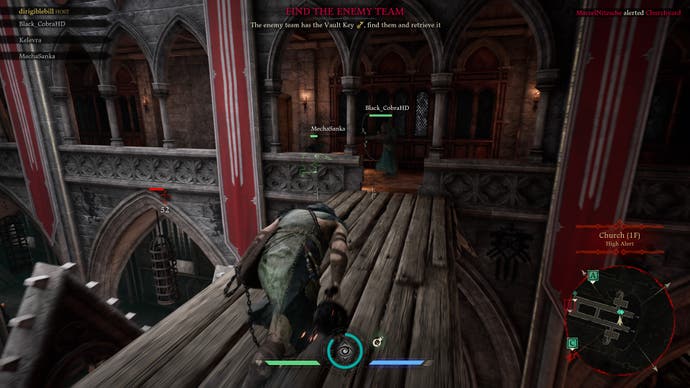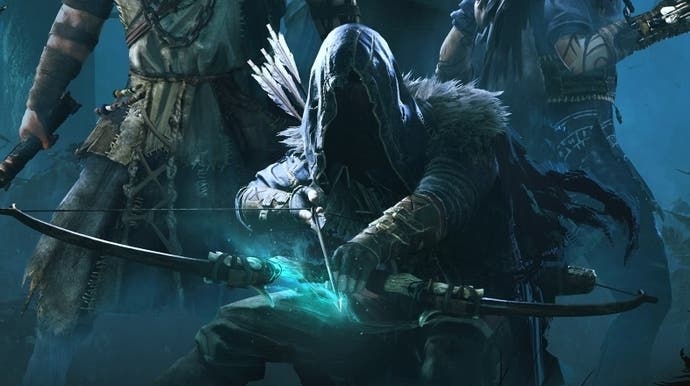Hood: Outlaws & Legends review - rangy multiplayer heists in a hopeless alternate England
Bowz n the Hood.
Robin Hood is the quintessential English folk rebel. He's also a total chameleon. The man (if he was a man) has undergone endless reincarnations, merry and not-so-merry, stretching back over 600 years of fact and fiction. Go on, pick your poison - no-nonsense Yorkshire highwayman or pantomime aristo? Crusading commoner or blueblood cheated of his birthright? Proto-socialist agitator or just a nickname given to any bandit of a certain repute? Errol Flynn or Russell Crowe?
The character has found a new lease of life overseas: I grew up not far from Robin's old stomping grounds in South Yorkshire, but the version of his story I fell in love with as a child was Disney's 1973 adaptation - Sherwood Forest by way of Kansas and the Jungle Book. Over time, sadly, this once-celebrated rogue has become something of an establishment figure. Robin's reinvention during the 19th century as the secret heir to a noble estate has less to do with historical evidence, and more reconciling him with England's rotten class system - a rebel no longer, but simply the "better" kind of toff trying to muscle his way back in.
What idea of Robin Hood is appropriate to the England of today, with its draconian anti-protest laws, plateauing wealth inequality and murderously incompetent ruling elite? A thoroughly grim one, of course, and on that count, Hood: Outlaws & Legends amply delivers. A lean multiplayer heist game from the team behind Eve: Valkyrie, it blends the murkier Robin myths with a very contemporary dread of a status quo that seems final and inescapable. The game isn't strictly set in England but a silent, shadowy composite of sunken villages, coastal forts and churchyards populated only by soldiers and gibbets. It feels more like Chernobyl than Sherwood, and like Chernobyl, it is a place out of time, ruled by a nameless, ahistorical State that is both crushingly tangible and strangely without form. Its castles are caught between periods - broadly medieval in design but with a hint of latter-day fascist architecture, made up of vast, square monoliths that seem beyond the era's technology.

In this retelling, Robin Hood is a faceless, fidgety rogue who looks like he'd be more comfortable scaling towers in Assassin's Creed. Old flame Maid Marion is now Marianne, a woad-painted assassin equipped with wristbow and smoke grenades (if there's any chemistry these days between her and Robin, it only ever takes the form of grisly executions). Jolly old Friar Tuck, or Tooke, is now a reformed torturer who wields a vicious spiked censer: he looks a bit like Pinhead off Hellraiser before the pins. Little John, at least, is still a hulking Good Boy with a hammer. The four invade strongholds and reclaim wealth on behalf of a "People" you'll never meet in the flesh, their dwellings always locked or abandoned. You can donate a portion of your match earnings to the common folk, but the only effect is to create fresh purchasing opportunities in your woodland hideout.
Robin's traditional adversaries, meanwhile, have been whittled down to a single Sheriff who owes more to Resident Evil than Alan Rickman - an implacable, wandering giant whose footfalls reverberate through the controller. There's no verbal jousting with this ironclad horror, and he'll kill you instantly if he gets close. But the Sheriff is just a distraction from Robin's real arch-nemesis, the Robin Hood on the other team. It invites a doom-ridden metaphysical analysis: in an empty England whose history has become a flat circle, orbiting the State, Robin must compete with different incarnations of his own myth, fighting spectral doppelgangers for fame, fortune and the sweetest outfits.

Slowly fleshed out through codex entries, all this makes a powerfully depressing backdrop for a deceptively simple game of Cops and Robbers and Robbers. The main 4v4 Heist mode has three acts - first, you track down the Sheriff and steal his key while his back is turned. Then you search for the vault, which is behind one of several doors across the map (the game tells you the rough area). Finally, somebody has to carry the chest to an extraction point on the perimeter, where one or two players must laboriously winch it over a wall while their team-mates fend off the opposing outlaws. Main objectives aside, you'll probably want to claim a spawn point or two and explore for gear or ammo boxes. You can also skirmish with the other side - thinning their numbers ahead of a big push, or tying them up while your allies make off with the prize.
Beyond its simple third-person movement and combat, the trick to Hood is that focusing on the objective not only makes it harder to fight the other team, but may actively help them. Get the key first and your enemies can always ambush you while you're fleeing the Sheriff. Crack the vault and the other team can trap you inside, with one team-mate unable to fight while carrying the chest, and the others potentially weakened from clashes with guards. Start the extraction and you're not only painting a target on your back but propelling both teams closer to victory. Filling segments of the extraction bar earns bonuses, but you only need to fill the very last segment to win. As a consequence, it's possible to spend most of a match beating the other team like a carpet, only to get knocked flat on your arse in the closing seconds.
Visibility and the lack thereof are everything in Hood. Maps are vast, gloomy, multiple-storey and packed with dense vegetation and blind corners. Everybody, even Little John, can get the drop on you while they're crouched. Tagging guards and other players is therefore vital - and strongly incentivised by the scoring system. The local garrison isn't just a terrain hazard and low-key XP farming opportunity but an apparatus of mutual surveillance: any rival player the guards spot also appears on your HUD. The tension between stealth and haste is uppermost in your mind at all times. The chest is invisible on HUDs while you're carrying it, so maybe think twice before jumping over the battlements - you'll drop it when you land, revealing your location. But wait, was that a hostile Marianne you glimpsed crossing the alley below? Perhaps there isn't time to take the stairs.

The characters are handsomely decked out in flapping cloth and dangling metal, but they're lean creations beneath the ornaments, with a couple of traits, a signature throwable (which must be collected in-game from gear chests) and a slow-charging ultimate ability. Robin is the sniper and spotter, armed with flashbangs for Ye Olde Breache and Cleare and an exploding arrow best saved for those last-ditch assaults on the extraction point. Marianne gets magic active camo and the ability to assassinate State soldiers from any direction. Her wristbow lacks range but can be charged to fire three bolts in a burst, making it better against moving targets at close quarters. Her smoke grenades are inconvenient for enemy Robins but more so for guards, rooting them in place so that she can shiv them all in succession.
Little John is the brawler, as you'd expect, able to dizzy opponents with overarm hammer blows or parry them off balance; his throwable is a basic grenade, while his Warcry ultimate gives him extra stamina and resilience, letting him barge through groups. Tooke is a support-oriented skirmisher, his whirling censer keeping attackers at bay. His gas bombs impede stamina recovery, forcing enemies out of chokepoints, while his ultimate heals nearby friends and tags enemies through walls. Each class also has different ways of traversing the map. Robin and Marianne can shoot down ropes to climb walls, while Little John can lift portcullises, which drop when guards raise the alert. Tooke lacks a unique traversal skill, but he does have a passive perk that speeds up allies nearby.
The perks - of which you can equip up to three - are pretty unexciting, more about tweaking your strategy than acquiring a new one. Think stronger attacks that cost more stamina, or explosive arrows that detonate on impact for a smaller blast radius. They grow more and more decisive, however, as you master the intricacies of a game where victory is typically measured in seconds and centimetres. Hood puts a compelling emphasis on thrifty play. Robin, prince of archers, gets just seven arrows to begin with - you can reclaim arrows from walls, but it's no substitute for aiming carefully. Wanton killing is quietly discouraged, even when on the rampage as Tooke or Little John: there are no streak rewards or K/D stats in the lobby, and you'll quickly run out of stamina if you button-mash, leaving you unable to block, dodge or sprint.

At its best, Heist is an atmospheric and engrossing tussle of wills reminiscent of Crytek's Hunt: Showdown. There's an enjoyable mystery to it all, as you build up a picture of the other team's composition and priorities from early skirmishes and HUD hints, getting a sense of the personalities involved. Unsuspected tactical wrinkles reveal themselves - luring the Sheriff over to play Tag around the extraction point when the other team is ahead, for example (thankfully, the big lunk never tries to restore the chest to the vault). Other times, however, it's a bit of a mess. The extraction phase is too often an attritional exercise in racing back from your spawn to kill precisely one player before getting slaughtered in turn by an enemy player racing back from theirs. Often, the match is decided not by individual duels over the winch but claiming the nearest spawn point and so, ensuring a faster flow of bodies to the mincing machine.
Hood's more immediate problem is a shortage of modes. At the time of review, all you get are Heist on six maps, plus 1-4 player training matches against the AI. It's a juicier package than I've just made it sound - the map design does a good job of teasing possibilities out of classes that can seem anaemic on paper - but after a week with the game, I feel like I've had enough. At the time of writing, finding seven other players is also a bit of a slog. Much as the crossplay support will be vital to keeping Hood's nascent community intact, mixing PC with console users has predictable repercussions in a game where everybody can play the sniper. In my experience, console players often quit the lobby when they're up against a full complement of mouse-and-keyboard users.
Hunt launched with a similarly slender mode offering, but it had a richer assortment of weapons and variables, even discounting its showpiece bossfights. Hood is a worthy alternative with a mood all of its own, but it's not quite in the same league. Or at least, not yet. Post-launch plans include a new competitive mode, map and a character class (fingers crossed it's the chicken from Disney's film, and not sulky Will Scarlet). I won't be playing much in the meantime, but I'm interested to see what this eerie and despondent reworking of England's original renegade turns into, a year from now.










